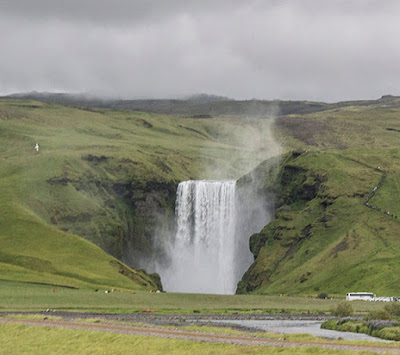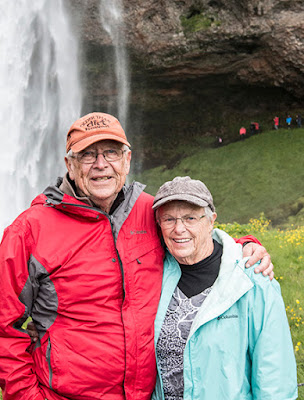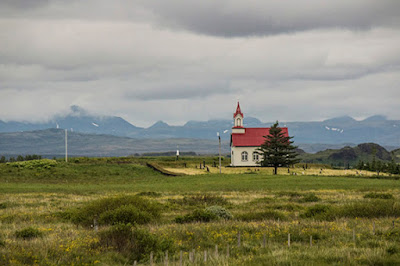
The good (or bad) part of it was that was we seemed to travel over some of the same roads as the day before.

The "marshmellow" fields with grasses wrapped tightly in white (though sometimes in pink, light blue of black) plastic ready to feed the animals during the cold season.
The rich green countryside with purple lupine and mountains and rivers in the background.
The smooth deposit of ash from many volcanic eruptions covered with vegetation and bordered by trees.
And the steep fronts of mountains and cliffs laced with waterfalls
We circled large fjords such as the Whale Fjord or Hvalfjörður a 30 km long fjord surrounded by volcanic mountains and green terrain in the summer months.
This beautiful Fjord was used by British and US troops during the 2nd WW as a Naval Base, and the remains can be seen today.
On
the fjord is Iceland’s only operational whaling station, operated by
Hvalur Ehf., which makes use of one of the piers that the US Navy had
built. In my mind it is still one too many
depicting volcanic activity, earthquakes and the creation of Iceland over millions of years.
The museum is located in town of Hvolsvöllur, , and is within viewing distance of three volcanoes: Katla, Hekla, and Eyjafjallajökull, which shut down European airspace when it erupted in 2010.
On out way to a delicious lunch at the Country Inn Anna, we passed these old houses buried in the ground. They must have been warmer in the winter if the snow didn't come this high.
These horses were a few of the ones on the hills above where we had lunch. In Iceland there are about 80,000 horses (compared to about 317,000 humans) and about 100,000 abroad. For centuries Icelandic horses have lived half wild and half tame. In the summer farmers drive them to the highlands, where they live without human care for months. Icelandic Horses are
in great demand, and though they can be sold and exported, none can be imported. The stock is pure and healthy, and the government intends to keep it that way.
This old hut above the restaurant where we ate took my interest. Wonder if it was once a house, or if it was a shelter for animals?
We stopped at this massive glacier called Solheimajokull, where some of the group (not us) went for a walk on the glacier. Having done this on the Mendenhall Glacier in Alaska years ago, this dirty one didn't interest me, particularly in the rain.
The run-off made for interesting patterns in the "parking lot" though.
What did interest me though was this beautiful, majestic waterfall nearby called Skogafoss.

Going on we passed this "Pile" of cows happily resting near the road.
And this family of sheep safely nestled among the rocks.
The Seljalandsfoss waterfall is one of the highest waterfalls in Iceland. It is fed by melting water from the famed glacier-capped Eyjafjallajokull volcano. What makes it so unusual is that you can walk behind it.
In the background here you can see people starting to walk behind the falls.
I was content with the beautiful plants and flowers along the river.
We passed this group of horses by the road, including one very curious colt.
This field was completely mowed and packed away for later use.
This rushing river was spanned by an interesting bridge, pedestrian?
This hillside strewn with large boulders shows the debris from a recent volcanic eruption.
A welcome gift from the United states, a relatively new power plant.
And the last photo from this busy day, the tourists standing atop the rift at the pingvellir National Park, a UNESCO World Heritage Site. But that I will leave for tomorrow, our 3nd and last day in
Iceland, Do you think the sun will shine?? NO!!




























No comments:
Post a Comment